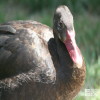Plectropterus gambensis
The spur-winged goose is a large, powerful, broad-winged bird with an odd spur on the forepart of the wing. Despite its large size (30 to 40" long, 14 to 22 lbs.), and ground-nesting habits which led to its being called a goose, it is actually a perching duck. The coloring is generally black and white with iridescent bronze-green upper parts and a gray-blue bare face. Males are larger than females. The males develop a knob on the forehead as they mature, a feature which may be found on the female but is much less conspicuous on her. The voice of the male is a thin, squeaky whistle; females are generally silent.
Spur-winged geese often roost and occasionally nest in trees. They fly heavily, with wings flapping slowly and noisily. These non migratory birds gather in large flocks and, because they enjoy planted vegetable matter, can cause considerable damage to crops. Feeding takes place mostly in the evening or early morning, but on moonlit nights may continue to morning. Birds usually do not roost in feeding areas, and fly daily from one area to another.
The breeding season varies in parts of the range: February to July in Zambia, January to May in Zimbabwe, September to April in South Africa. The nest is usually on the ground among thick grasses, or in reedbeds, but has also been found in rocks in mountainous country, in holes in termite mounds, and in holes in trees. It is a large structure of reeds, grasses and roots, lined with down. Only the females incubate the eggs. Like many waterfowl the young are led to water soon after hatching.
The genus name, Plectropterus, is from the Greek plektron, ‘a cock’s spur’ and pteron, ‘feathers, or can mean wings’ The species name, gambensis, refers to the country Gambia, although this bird is not restricted to that country.

